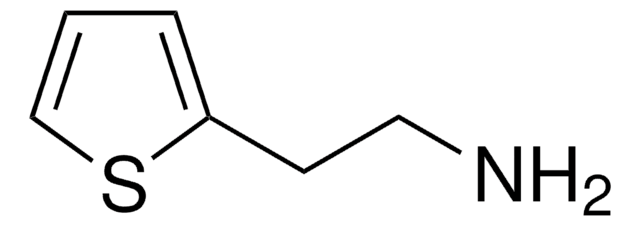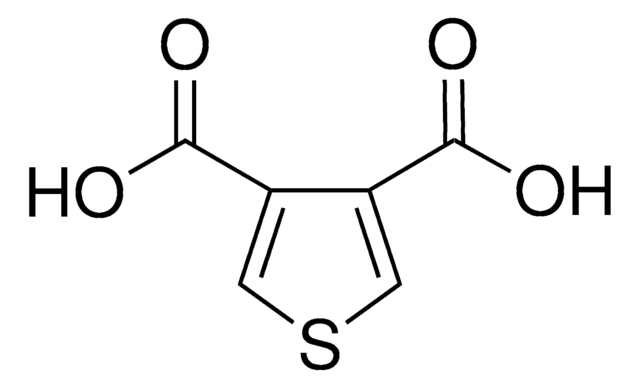767743
2,5-Dihydro-3,6-di-2-thienyl-pyrrolo[3,4-c]pyrrole-1,4-dione
97%
Sinónimos:
3,6-Di(thiophen-2-yl)pyrrolo[3,4-c]pyrrole-1,4(2H,5H)-dione, DPP
Iniciar sesiónpara Ver la Fijación de precios por contrato y de la organización
About This Item
Fórmula empírica (notación de Hill):
C14H8N2O2S2
Número de CAS:
Peso molecular:
300.36
Número MDL:
Código UNSPSC:
12352103
ID de la sustancia en PubChem:
NACRES:
NA.23
Productos recomendados
Nivel de calidad
Ensayo
97%
Formulario
solid
cadena SMILES
O=C1NC(c2cccs2)=C3C(=O)NC(c4cccs4)=C13
InChI
1S/C14H8N2O2S2/c17-13-9-10(12(16-13)8-4-2-6-20-8)14(18)15-11(9)7-3-1-5-19-7/h1-6H,(H,15,18)(H,16,17)
Clave InChI
YIUHGBNJJRTMIE-UHFFFAOYSA-N
Categorías relacionadas
Descripción general
2,5-Dihydro-3,6-di-2-thienyl-pyrrolo[3,4-c]pyrrole-1,4-dione is a diketopyrrolopyrrole (DPP) based copolymer and are used widely in thin-film transistors and solar cell devices. This aromatic polymer has electron withdrawing groups and hence is very useful for the synthesis of narrow band gap donor-acceptor polymers which are used as active semiconductors for organic electronics. They give rise to high power conversion efficiency (PCE) in Organic Photovoltaic (OPV) Cells.
Aplicación
Used in the synthesis of donor-acceptor polymers which are used in polymer field-effect transistors and bulk heterojunction solar cells.
Características y beneficios
Diketopyrrolopyrrole is planar and can accept hydrogen bonds/other electrostatic interactions which results in copolymers that have pi-pi stacking.
Palabra de señalización
Warning
Frases de peligro
Consejos de prudencia
Clasificaciones de peligro
Acute Tox. 4 Oral - Eye Irrit. 2 - Skin Irrit. 2 - STOT SE 3
Órganos de actuación
Respiratory system
Código de clase de almacenamiento
11 - Combustible Solids
Clase de riesgo para el agua (WGK)
WGK 3
Punto de inflamabilidad (°F)
Not applicable
Punto de inflamabilidad (°C)
Not applicable
Elija entre una de las versiones más recientes:
¿Ya tiene este producto?
Encuentre la documentación para los productos que ha comprado recientemente en la Biblioteca de documentos.
Los clientes también vieron
David Rais et al.
ChemPlusChem, 85(12), 2689-2703 (2020-12-18)
The singlet fission (SF) process discovered in bis(thienyl)diketopyrrolopyrroles (TDPPs) can boost their potential for photovoltaics (PV). The crystal structures of TDPP analogs carrying n-hexyl, n-butyl, or 2-(adamant-1-yl)ethyl substituents are similar, but contain increasingly slipped stacked neighbor molecules. The observed SF
Synthesis and characterization of phenanthrocarbazole-diketopyrrolopyrrole copolymer for high-performance field-effect transistors
Chen, H., Guo, Y., Sun, X., Gao, D., Liu, Y., & Yu, G.
Journal of Polymer Science Part A: Polymer Chemistry, 51(10), 2208-2215 (2013)
Influence of Side-Chain on Structural Order and Photophysical Properties in Thiophene Based Diketopyrrolopyrroles: A Systematic Study.
Naik, M. A., Venkatramaiah, N., Kanimozhi, C., & Patil, S.
The Journal of Physical Chemistry C, 116(50), 26128-26137 (2012)
Hugo Bronstein et al.
Journal of the American Chemical Society, 133(10), 3272-3275 (2011-02-22)
We report the synthesis and polymerization of a novel thieno[3,2-b]thiophene-diketopyrrolopyrrole-based monomer. Copolymerization with thiophene afforded a polymer with a maximum hole mobility of 1.95 cm(2) V(-1) s(-1), which is the highest mobility from a polymer-based OFET reported to date. Bulk-heterojunction
Nuestro equipo de científicos tiene experiencia en todas las áreas de investigación: Ciencias de la vida, Ciencia de los materiales, Síntesis química, Cromatografía, Analítica y muchas otras.
Póngase en contacto con el Servicio técnico![Benzo[1,2-b:4,5-b′]dithiophene-4,8-dione 97%](/deepweb/assets/sigmaaldrich/product/structures/418/544/b7faac0b-ad09-4b42-a9fa-aeb38017a39e/640/b7faac0b-ad09-4b42-a9fa-aeb38017a39e.png)
![3,6-Bis(5-bromo-2-thienyl)-2,5-bis(2-hexyldecyl)-2,5-dihydro-pyrrolo[3,4-c]pyrrole-1,4-dione 98%](/deepweb/assets/sigmaaldrich/product/structures/128/499/590a62c1-529b-42e2-96df-25659ec8c9e0/640/590a62c1-529b-42e2-96df-25659ec8c9e0.png)

![1,1′-[4,8-Bis[5-(2-ethylhexyl)-2-thienyl]benzo[1,2-b:4,5-b′]dithiophene-2,6-diyl]bis[1,1,1-trimethylstannane]](/deepweb/assets/sigmaaldrich/product/structures/611/912/a638a6fe-ca7b-4674-8023-df4c0921a9fd/640/a638a6fe-ca7b-4674-8023-df4c0921a9fd.png)
![Dithieno[3,2-b:2′,3′-d]thiophene 97% (HPLC)](/deepweb/assets/sigmaaldrich/product/structures/502/826/9222eb9f-669e-4f11-ad3a-91a3d43058cd/640/9222eb9f-669e-4f11-ad3a-91a3d43058cd.png)
![Thieno[3,2-b]thiophene 95%](/deepweb/assets/sigmaaldrich/product/structures/353/609/429fd4bf-e217-4371-80a3-9e5a4d88908b/640/429fd4bf-e217-4371-80a3-9e5a4d88908b.png)
![4,7-Dibromobenzo[c][1,2,5]thiadiazole 95%](/deepweb/assets/sigmaaldrich/product/structures/711/964/3fd3ffd1-5916-468e-a743-22f1611b5a33/640/3fd3ffd1-5916-468e-a743-22f1611b5a33.png)




